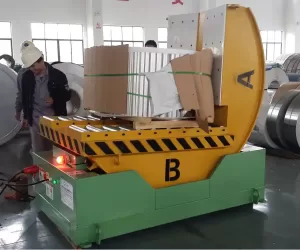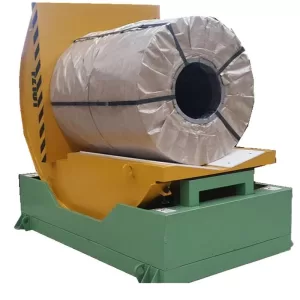Understanding Steel Coil Tilters and Upenders: Functionality and Applications
Steel coil tilters, often referred to as upenders or downenders, are essential pieces of heavy-duty material handling equipment specifically designed for the safe and efficient rotation of large, heavy steel coils. Handling these coils, which can weigh several tons, requires robust machinery to transition them between vertical (eye-to-sky) and horizontal (eye-to-wall) orientations for processing, storage, or transportation. This equipment plays a crucial role in improving operational safety and workflow efficiency in various industrial settings.
Video demonstrating a mechanical steel coil upender in operation.
What is a Steel Coil Tilter / Upender?
A Steel coil tilter is a mechanical or hydraulic device engineered to rotate coils, typically by 90 degrees. Its primary function is to reorient the coil's axis safely, minimizing the risk of damage to the material or injury to personnel that could occur with manual or less specialized handling methods. They are indispensable in environments dealing with rolled materials like steel, aluminum, or paper.
How Do Coil Tilters Work?

While designs vary, most coil tilters operate on a common principle:
- Loading: The coil is placed onto the tilter's platform or cradle, often using a forklift or overhead crane.
- Securing: Depending on the design, clamps or conforming platforms hold the coil securely in place during rotation.
- Tilting: A drive mechanism (mechanical gears/chains or hydraulic cylinders) powers the rotation of the platform or cradle, typically pivoting the coil 90 degrees.
- Unloading: Once reoriented, the coil is removed from the tilter using appropriate handling equipment.
Key Components and Features
Understanding the components is key to appreciating the functionality and reliability of these machines:
- Structural Frame: A heavy-duty, welded steel frame provides the necessary rigidity and strength to support multi-ton coils.
- Loading Platform/Cradle: The surface where the coil rests. It's often V-shaped or specially contoured to securely hold the coil during rotation. Some platforms may feature specific surfaces (e.g., polyurethane lining) to protect coil finishes.
- Drive System:
- Mechanical Tilters: Utilize electric motors, gear reducers, and heavy-duty roller chains or slewing rings to provide rotational force. They are known for reliability and consistent performance.
- Hydraulic Tilters: Employ hydraulic cylinders powered by a hydraulic power unit (HPU) to actuate the tilting motion. These often offer high load capacities and smooth operation.
- Bearings: Heavy-duty bearings (e.g., slewing rings, roller bearings) are critical for smooth rotation and supporting the immense weight and forces involved.
- Control System: Operator controls, typically push-button pendants or integrated panels, allow for safe initiation and management of the tilting cycle. Modern systems may include PLCs for automation and safety interlocks.
- Safety Features: Essential elements include emergency stops, safety guards or light curtains, overload protection, limit switches to control rotation, and sometimes mechanical locking mechanisms to secure the platform during loading/unloading.
Applications in Industry
Steel coil tilters and upenders are vital in numerous sectors:
- Steel Mills: Reorienting coils after production for storage or transport.
- Service Centers: Positioning coils for slitting, cutting, or other processing lines.
- Stamping and Fabrication Plants: Preparing coils for feeding into presses or other manufacturing equipment.
- Logistics and Warehousing: Tilting coils for efficient palletizing, racking, or container loading.
Safety Considerations
Given the significant weights involved, safety is paramount when operating coil handling equipment:
- Operator Training: Only trained and authorized personnel should operate coil tilters.
- Load Capacity: Never exceed the manufacturer's specified maximum load capacity.
- Stable Loading: Ensure coils are properly centered and stable on the platform before initiating the tilt cycle.
- Clear Zone: Maintain a clear area around the equipment during operation.
- Regular Inspections: Conduct routine checks for wear, damage, or malfunction, particularly on lifting components, safety devices, and drive systems. Adherence to established safety standards or equivalent regional bodies, is critical.
Maintenance Best Practices

Regular maintenance ensures the longevity and reliable operation of steel coil tilters:
- Lubrication: Follow the manufacturer's schedule for lubricating bearings, chains, gears, and other moving parts.
- Component Inspection: Regularly inspect chains for tension and wear, hydraulic systems for leaks, hoses for damage, and structural welds for integrity.
- Electrical Systems: Check wiring, control panels, and safety switches.
- Fluid Levels: For hydraulic units, maintain proper hydraulic fluid levels and quality.
In summary, mechanical and hydraulic steel coil tilters are robust machines essential for safe and efficient material handling in the metals industry. Their proper selection, operation, and maintenance are crucial for productivity and workplace safety. Specialized designs, such as a tilter with a sliding table, can further enhance functionality for specific application needs.